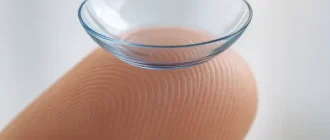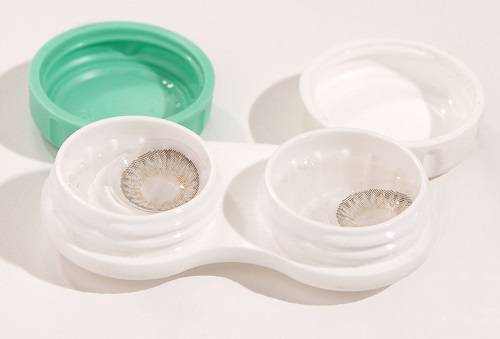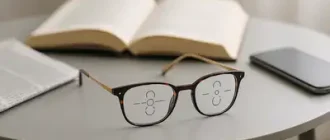Bifocal contact lenses are revolutionizing how people deal with presbyopia, the age-related loss of close-up vision that usually begins after age 40. For those who are tired of reaching for reading glasses or switching between multiple pairs of glasses, bifocal contact lenses can be a liberating alternative. But how do they work, and are they worth the cost? In this guide, we’ll explore the nuances of bifocal contact lenses, who they are for, and the latest trends in multifocal eye care.
The Basics: How Do Bifocal Contact Lenses Work?

Bifocal contact lenses have two different prescription powers in a single lens, much like bifocal glasses. However, unlike traditional glasses that have a visible line, these lenses are designed with a blend of two prescriptions to correct both distance and near vision. The result is clear vision at all ranges without the hassle of looking over or under your glasses.
There are two primary types of bifocal contact lenses:
- Alternating Vision Lenses: These mimic traditional bifocals by having distinct areas for near and far vision. Your eye moves between the two sections, depending on what you’re focusing on.
- Simultaneous Vision Lenses: With these, different parts of the lens are used for near and distance vision simultaneously. Your brain learns to interpret the visual information, focusing on what is most needed.
Multifocal vs. Bifocal: A common point of confusion is the difference between bifocal and multifocal lenses. Bifocal lenses offer two distinct prescriptions, while multifocal lenses have a gradient of power, offering a smoother transition between close-up, intermediate, and distance vision. For some, this makes multifocal lenses a preferable choice.
Who Needs Bifocal Contact Lenses? Insights from Data
Presbyopia affects over 1.8 billion people worldwide, according to the World Health Organization. In the United States alone, approximately 128 million people are presbyopic, making it one of the most common visual impairments for adults over 40. Bifocal contact lenses are often prescribed for those who:
- Want to avoid the inconvenience of reading glasses.
- Lead active lifestyles where wearing glasses is cumbersome.
- Desire a more natural appearance without glasses.
In a recent survey by the American Academy of Ophthalmology, 78% of patients who opted for bifocal contact lenses reported greater satisfaction compared to traditional bifocal glasses, citing freedom and comfort as key benefits.
Types of Bifocal Contact Lenses: Which One is Right for You?
Choosing the right bifocal contact lenses can depend on your lifestyle and specific vision needs. Below is a quick breakdown of the types available:
| Lens Type | Description | Cost Estimate (per box) |
|---|---|---|
| Soft Bifocal Lenses | Made of soft hydrogel or silicone hydrogel, offering comfort. | $30 – $90 |
| Rigid Gas Permeable | Provide sharper vision but take longer to get used to. | $60 – $150 |
| Daily Disposable | Ideal for convenience, changed every day. | $40 – $100 |
| Extended Wear | Worn continuously for up to 30 days. | $70 – $150 |
Soft Bifocal Lenses are the most popular due to their comfort. However, Rigid Gas Permeable (RGP) lenses can provide crisper vision, especially for those with significant astigmatism. Daily disposables are a preferred choice for those who prioritize hygiene and convenience.
Real World Use: What Are People Saying?
Many users report a period of adaptation when switching to bifocal contact lenses. Dr. Sarah Thompson, an optometrist with 15 years of experience, explains, “It’s normal for patients to need a few weeks to fully adjust. The brain has to learn how to prioritize the visual information from different zones in the lenses.” She also notes that while some patients may struggle initially, over 85% of wearers end up feeling comfortable and satisfied after the adjustment period.
One patient, a 48-year-old teacher named Linda, shared her experience: “I was nervous about giving up my glasses, but after a week of wearing bifocal contacts, I could read to my students and see across the classroom without issue. The transition took some time, but now I can’t imagine going back.” Linda’s story echoes that of many others who find bifocal contacts a practical solution for an active life.
How Much Do Bifocal Contact Lenses Cost? A Look at the Numbers
The cost of bifocal contact lenses can vary widely, depending on the type of lens, brand, and frequency of replacement. On average, bifocal lenses cost between $30 and $150 per box, with each box typically containing enough lenses for a month or more, depending on wear schedule.
| Factor | Impact on Cost |
|---|---|
| Material | Soft lenses tend to be cheaper than RGP lenses. |
| Replacement Frequency | Daily disposables are more expensive overall. |
| Brand | Premium brands may offer better comfort, at a cost. |
| Special Features | UV protection or tinted lenses can add to the cost. |
It’s also essential to consider the fitting process, which is usually more complex for bifocal or multifocal lenses than for single-vision lenses. An initial fitting can range from $100 to $250, and follow-up visits may add to the expense. However, most users find the cost justified by the convenience and comfort these lenses offer.
Emerging Trends: The Future of Bifocal Contact Lenses
As technology advances, bifocal contact lenses are becoming increasingly sophisticated. Custom-made lenses, designed to match the exact curvature of the eye, are gaining popularity for their improved comfort and precision. Another emerging trend is the use of photochromic contact lenses, which adjust to changing light conditions, providing an extra layer of comfort for those sensitive to bright light.
The use of digital eye strain reduction features in bifocal lenses is also on the rise. With more people working on screens, lenses that help mitigate blue light and reduce eye fatigue are becoming a significant selling point. In fact, 62% of contact lens users under 50 reported interest in lenses that specifically address digital eye strain, according to a 2023 market survey by Vision Direct.
Potential Downsides: When Bifocal Contacts May Not Be the Best Option
While bifocal contact lenses have many advantages, they aren’t perfect for everyone. Some common challenges include:
- Adaptation Period: It can take one to two weeks for your eyes to adjust to the new way of seeing.
- Reduced Night Vision: Some users report glare or halos at night, which can make driving difficult.
- Cost: As outlined earlier, bifocal lenses are often more expensive than standard contacts, especially when considering the fitting process and additional follow-ups.
Dr. Thompson advises, “For those who drive extensively at night or have particularly sensitive vision, bifocal contact lenses may not always be the ideal solution. There are other corrective measures like monovision contacts or simply using reading glasses when needed.”
Our Editorial Team’s Advice for Finding the Right Fit
If you’re considering bifocal contact lenses, the first step is consulting with an eye care professional who understands your needs. It’s important to be patient during the adjustment period and to try different types of lenses if the first ones aren’t quite right. Daily disposables might work for some, while extended wear may suit others better. Remember, finding the perfect fit is often a process of trial and error.
For those struggling with digital eye strain, you may want to ask about bifocal lenses designed to reduce blue light exposure. And while the cost might be higher than standard contact lenses, the benefits of not having to juggle multiple pairs of glasses can be well worth the investment.
Ultimately, bifocal contact lenses offer a modern solution to an age-old problem—providing clear vision at all distances without the hassle of frames. Whether you’re an avid reader, an athlete, or someone who simply wants to keep life hands-free, bifocal contacts can make a significant difference in your quality of life.





